1884 ‘Rudens’ performance media gallery
The performance of Rudens by the Washington University Ladies’ Literary Society was met with great local excitement before and after its staging. Here, St. Louis’ major newspaper and the campus paper provide a first-hand account of the play’s reception.
Images 1–3: Washington University Student Life, May 1884
Image 4: St. Louis Post-Dispatch, April 26, 1884
Click on each image to read the text.
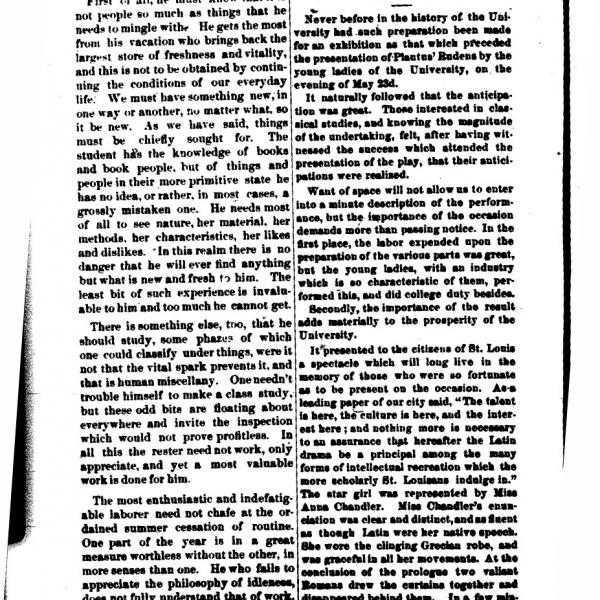
Student Life, First page
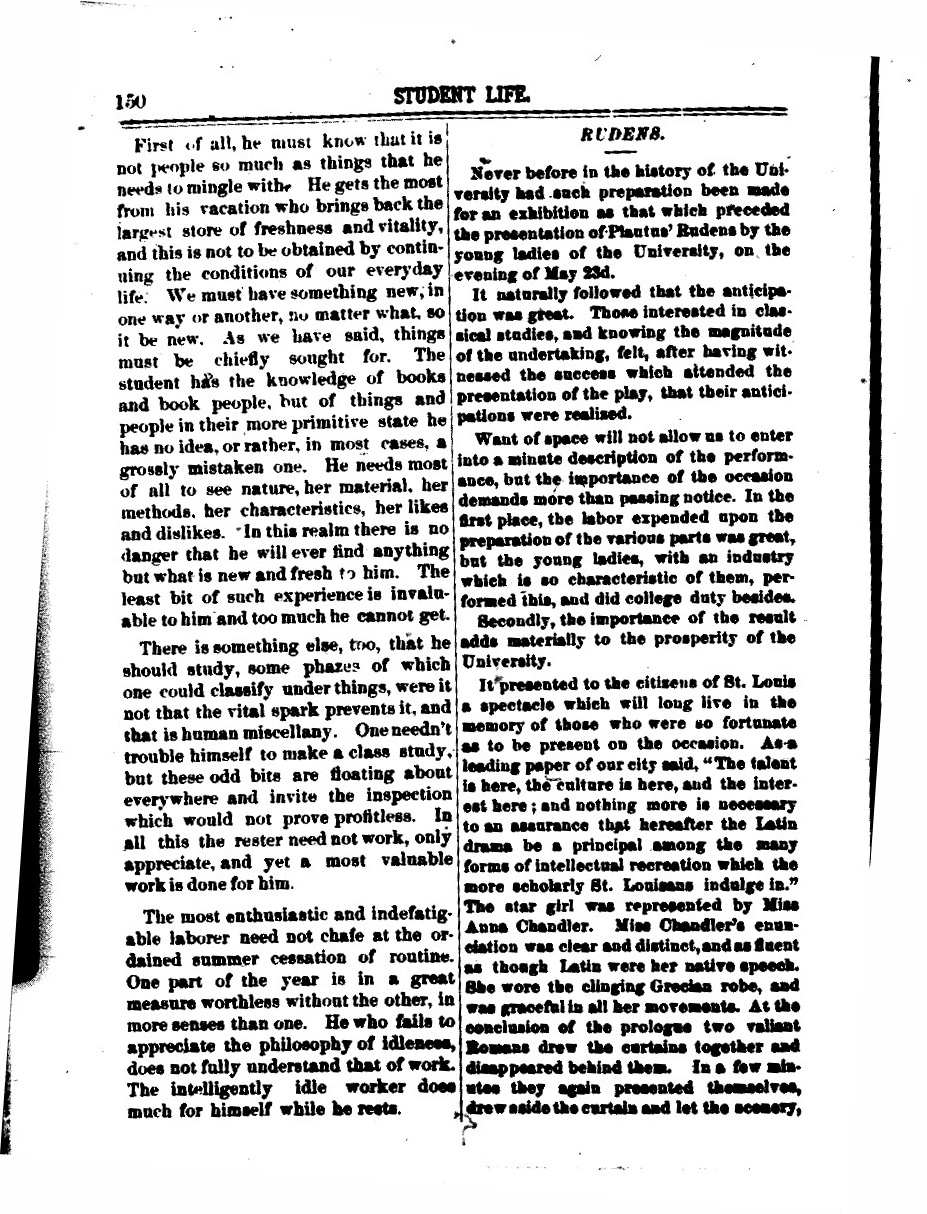
Washington University Student Life, May 1884, first page
Rudens.
Never before in the history of the University had such preparation been made for an exhibition as that which preceded the presentation of Plautus’ Rudens by the young ladies of the University, on the evening of May 23d.
It naturally followed that the anticipation was great. Those interested in classical studies, and knowing the magnitude of the undertaking, felt, after having witnessed the success which attended the presentation of the play, that their anticipations were realized.
Want of space will not allow us to enter into a minute description of the performance, but the importance of the occasion demands more than passing notice. In the first place, the labor expended upon the preparation of the various parts was great, but the young ladies, with an industry which is so characteristic of them, performed this, and did college duty besides.
Secondly, the importance of the result adds materially to the prosperity of the University.
It presented to the citizens of St. Louis a spectacle which will long live in the memory of those who were so fortunate as to be present on the occasion. As a leading paper of our city said, “The talent is here, the culture is here, and the interest here; and nothing more is necessary to an assurance that hereafter the Latin drama be a principal among the many forms of intellectual recreation which the more scholarly St. Louisans indulge in.” The star girl was represented by Miss Anna Chandler. Miss Chandler’s enunciation was clear and distinct, and as fluent as though Latin were her native speech. She wore the clinging Grecian robe, and was graceful in all her movements. At the conclusion of the prologue two valiant Romans drew the curtains together and disappeared behind them. In a few minutes they again presented themselves, drew aside the curtains and let the scenery,
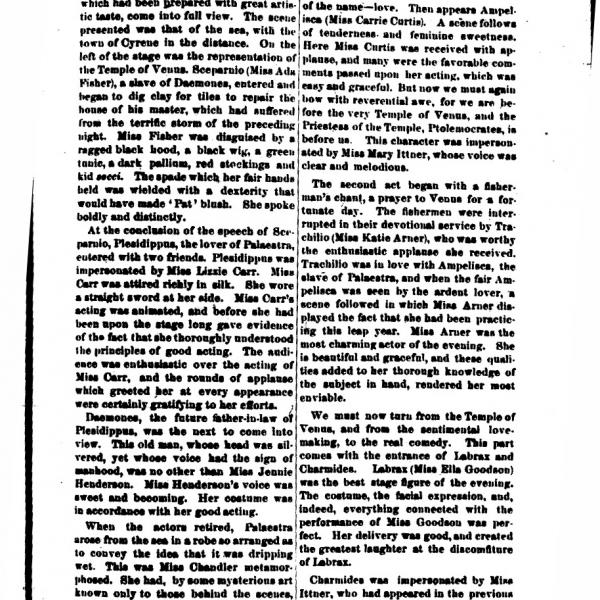
Student Life, Second page
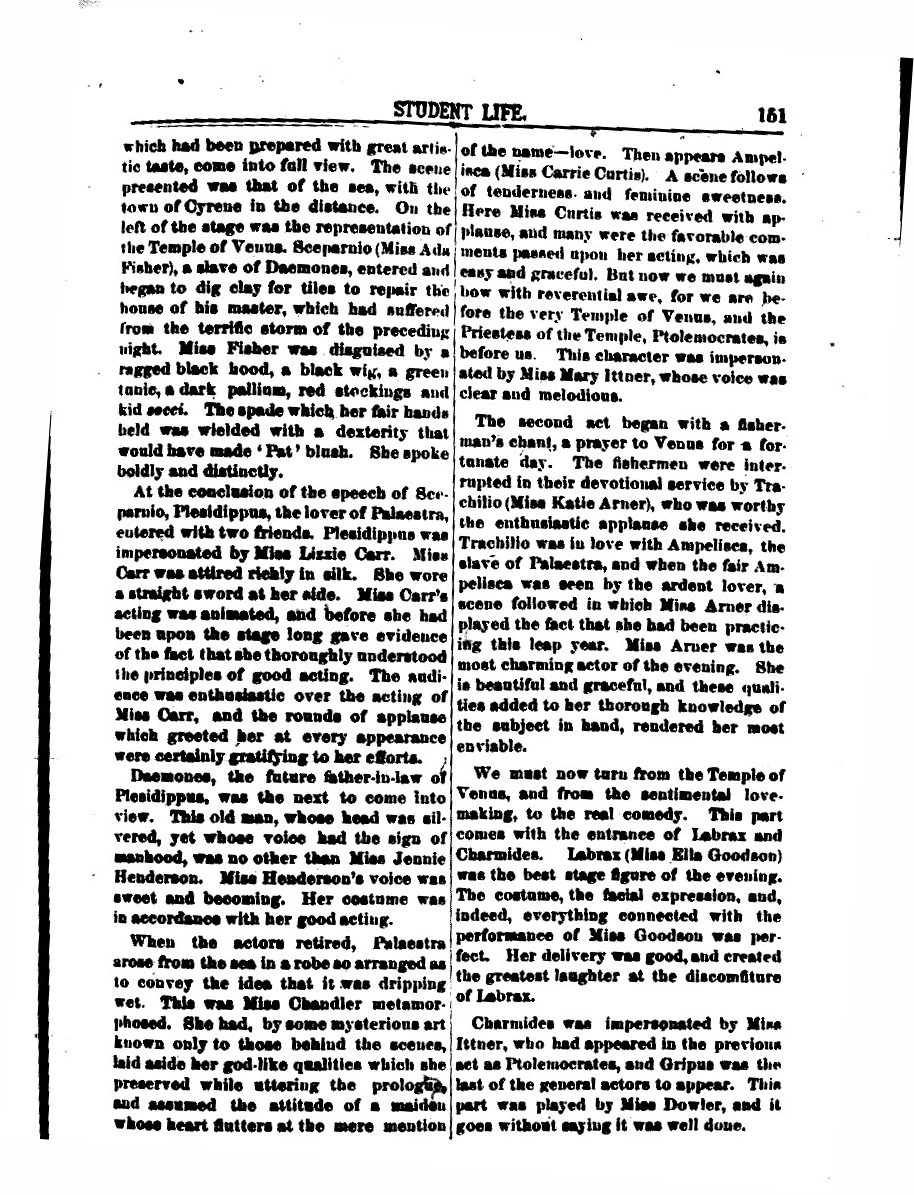
Washington University Student Life, May 1884, second page
which had been prepared with great artistic taste, come into full view. The scene presented was that of the sea, with the town of Cyrene in the distance. On the left of the stage was the representation of the Temple of Venus. Sceparnio (Miss Ada Fisher), a slave of Daemones, entered and began to dig clay for tiles to repair the house of his master, which had suffered from the terrific storm of the preceding night. Miss Fisher was disguised by a ragged black hood, a black wig, a green tunic, a dark pallium, red stockings and kid secci. The spade which her fair hands held was wielded with a dexterity that would have made ‘Pat’ blush. She spoke boldly and distinctly.
At the conclusion of the speech of Sceparnio, Plesidippus, the lover of Palaestra, entered with two friends. Plesidippus was impersonated by Miss Lizzie Carr. Miss Carr was attired richly and silk. She wore a straight sword at her side. Miss Carr's acting was animated, and before she had been upon the stage long, gave evidence of the fact that she thoroughly understood the principles of good acting. The audience was enthusiastic over the acting of Miss Carr, and the rounds of applause which greeted her at every appearance were certainly gratifying to her efforts.
Daemones, the future father-in-law of Plesidippus, was the next to come into view. This old man, whose head was silvered, yet whose voice had the sign of manhood, was no other than Miss Jennie Henderson. Miss Henderson's voice was sweet and becoming. Her costume was in accordance with her good acting.
When the actors retired, Palaestra arose from the sea, in a robe so arranged as to convey the idea that it was dripping wet. This was Miss Chandler metamorphosed. She had, by some mysterious art known only to those behind the scenes, laid aside her god-like qualities which she had preserved while uttering the prologue, and assumed the attitude of a maiden whose heart flutters at the mere mention of the name—love. Then appears Ampelisca (Miss Carrie Curtis). A scene follows of tenderness and feminine sweetness. Here Miss Curtis was received with applause, and many were the favorable compliments passed upon her acting, which was easy and graceful. But now we must again bow with reverential awe, for we are before the very Temple of Venus, and the Priestess of the temple, Ptolemocrates, is before us. This character was impersonated by Miss Mary Ittner, whose voice was clear and melodious.
The second act began with a fisherman's chant, a prayer to Venus for a fortunate day. The fishermen were interrupted in their devotional service by Trachilio (Miss Katie Arner), who was worthy of the enthusiastic applause she received. Trachilio was in love with Ampelisca. The slave of Palaestra, and when the fair and Ampelisca was seen by the ardent lover, a scene followed in which, Miss Arner displayed the fact that she had been practicing this leap here. Miss Arner was the most charming actor of the evening. She is beautiful and graceful, and these qualities added to her thorough knowledge of the subject at hand, rendered her most enviable.
We must now turn from the Temple of Venus, and from the sentimental love-making, to the real comedy. This part comes with the entrance of Labrax and Charmides. Labrax (Miss Ella Goodson) was the best stage figure of the evening. The costume, the facial expression, and, indeed, everything connected with the performance of Miss Goodson was perfect. Her delivery was good, and created the greatest laughter at the discomfiture of Labrax.
Charmides was impersonated by Miss Ittner, who had appeared in the previous act as Ptolemocrates, and Gripus was the last of the general actors to appear. This part was played by Miss Dowler, and it goes without saying it was well done.
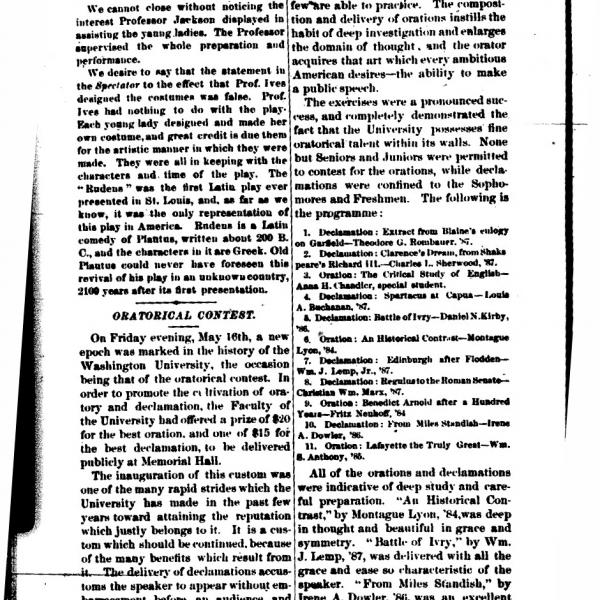
Student Life, Third page
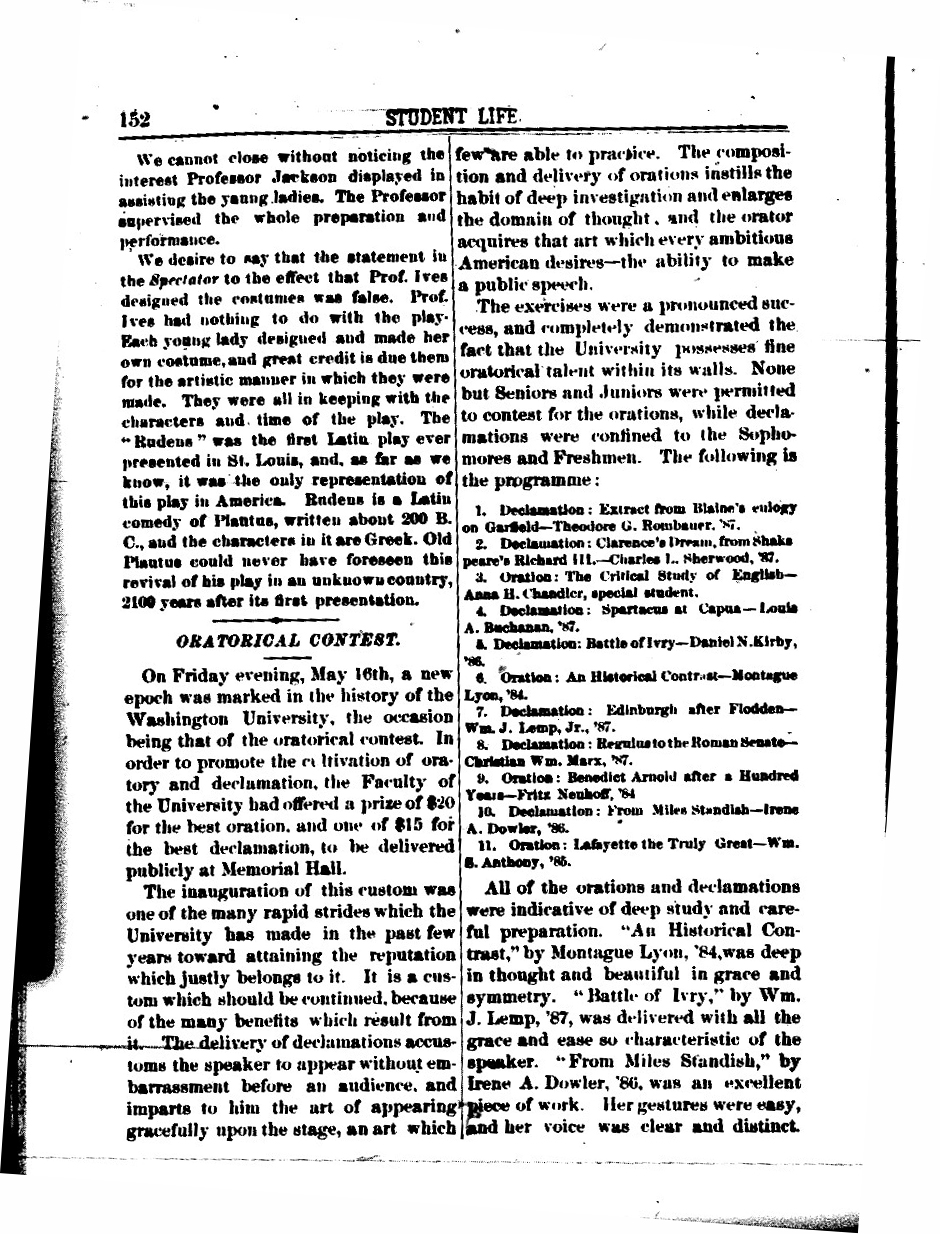
Washington University Student Life, May 1884, third page
We cannot close without noticing the interest, Professor Jackson displayed in assisting the young ladies. The professor supervised the whole preparation and performance.
We desire to say that the statement in the Spectator to the effect that Prof. Ives designed the costumes was false. Prof. Ives had nothing to do with the play. Each young lady designed and made her own costume and great credit is due them for the artistic manner in which they were made. They were all in keeping with the characters and time of the play. The “Rudens” was the first Latin play ever presented in St. Louis. And as far as we know it was the only representation of this play in America. Rudens is a Latin comedy of Plautus written about 200 B.C., and the characters in it are Greek. Old Plautus could never have foreseen this revival of his play in an unknown country, 2100 years after its first presentation.
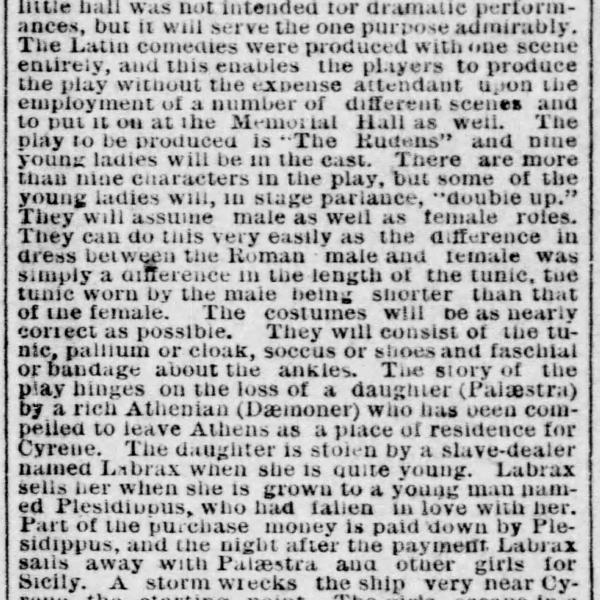
Post-Dispatch article

